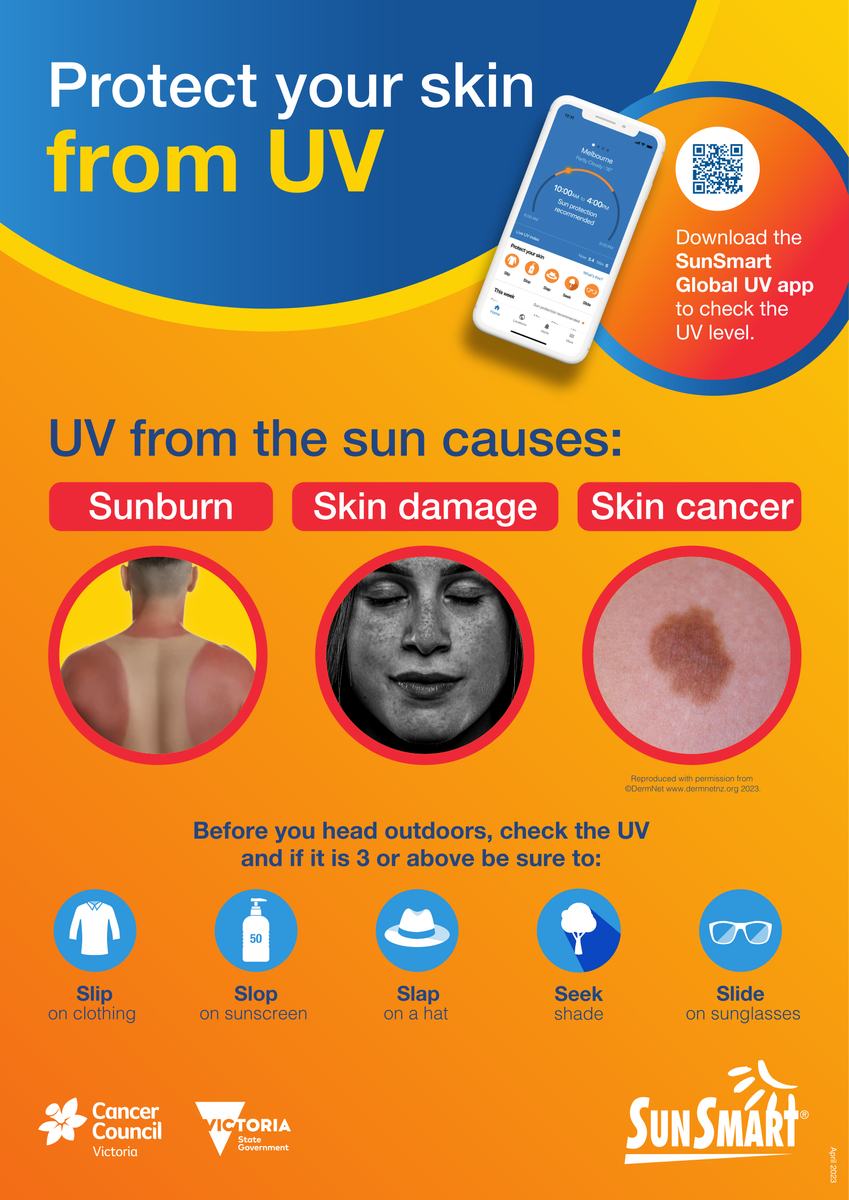Time to be Sun Smart

Families love being outdoors and being active. But being outdoors means you and your family can be exposed to UV radiation.
To protect your family’s health and create habits that your children can carry with them through life, make sure your family know when the UV hits 3 and the best ways to cover up from UV.
Know your UV
If the UV is 3 or above, make sure your family uses five forms of sun protection by wearing a hat, clothing and sunglasses, applying sunscreen and enjoying shady areas outdoors to give you extra coverage.
Overexposure to the sun’s ultraviolet (UV) radiation during childhood and adolescence is a major risk factor for skin cancer. Melanoma is one of the most diagnosed cancers in Victorians aged 15 to 29 years and is caused by UV damage.
Role model for sun protection behaviours
Parents and carers are powerful role models.
When you use all five forms of sun protection, not only is it protecting you, it means children are more likely to use them too.
Make sun protection part of your daily routine to show how to be SunSmart.
Develop independent sun protection behaviours
Help make sun protection a part of the daily routine and encourage children to Slip, Slop, Slap, Seek and Slide.
Guide children to choose SunSmart clothing, create a sunscreen station for easy application before going outdoors, make sure hats and sunglasses are within reach, and promote outdoor play in shaded spaces.
Be a SunSmart family
Families love being outdoors and being active. But being outdoors means you and your family can be exposed to UV radiation.
To protect your family’s health and create habits that your children can carry with them through life, make sure your family know when the UV hits 3 and the best ways to cover up from UV.
- Clothing
- Sunscreen
- Hats
- Shade
- Sunglasses
Learn more about all five forms of sun protection
Know your UV
If the UV is 3 or above, make sure your family uses five forms of sun protection by wearing a hat, clothing and sunglasses, applying sunscreen and enjoying shady areas outdoors to give you extra coverage.
Download the free SunSmart Global UV app so you always know when to protect yourself and your family from the sun's UV.
Role model for sun protection behaviours
Parents and carers are powerful role models.
When you use all five forms of sun protection, not only is it protecting you, it means children are more likely to use them too.
Make sun protection part of your daily routine to show how to be SunSmart.
Develop independent sun protection behaviours
Help make sun protection a part of the daily routine and encourage children to Slip, Slop, Slap, Seek and Slide.
Guide children to choose SunSmart clothing, create a sunscreen station for easy application before going outdoors, make sure hats and sunglasses are within reach, and promote outdoor play in shaded spaces.
Find out more about SunSmart at school
Sun protection tips for families with teenagers
Exposure to UV radiation during childhood and adolescence is more likely to lead to skin cancer later in life.
How can I talk to my teenager about a tan?
Talking to teenagers about UV radiation and the damage it causes to skin cells can highlight the risk of being outdoors without sun protection.
When skin starts to change colour – what people often call a ‘tan’ – that’s a clear sign that damage is being done.
Damage caused by UV radiation is the single biggest factor in skin’s health and appearance, leading to premature ageing and skin cancer.
There is no such thing as a healthy tan.
How can I talk to my teenager about sunburn?
Sunburn is a sign of UV damage and even after the initial pain, peeling and colour goes away, the damage will linger.
UV exposure adds up over time. Skin remembers and records all UV exposure and DNA damage leading to an increased risk of skin cancer.
Sunburn and almost all skin cancers can be prevented by using sun protection.
Find out more to end the trend

